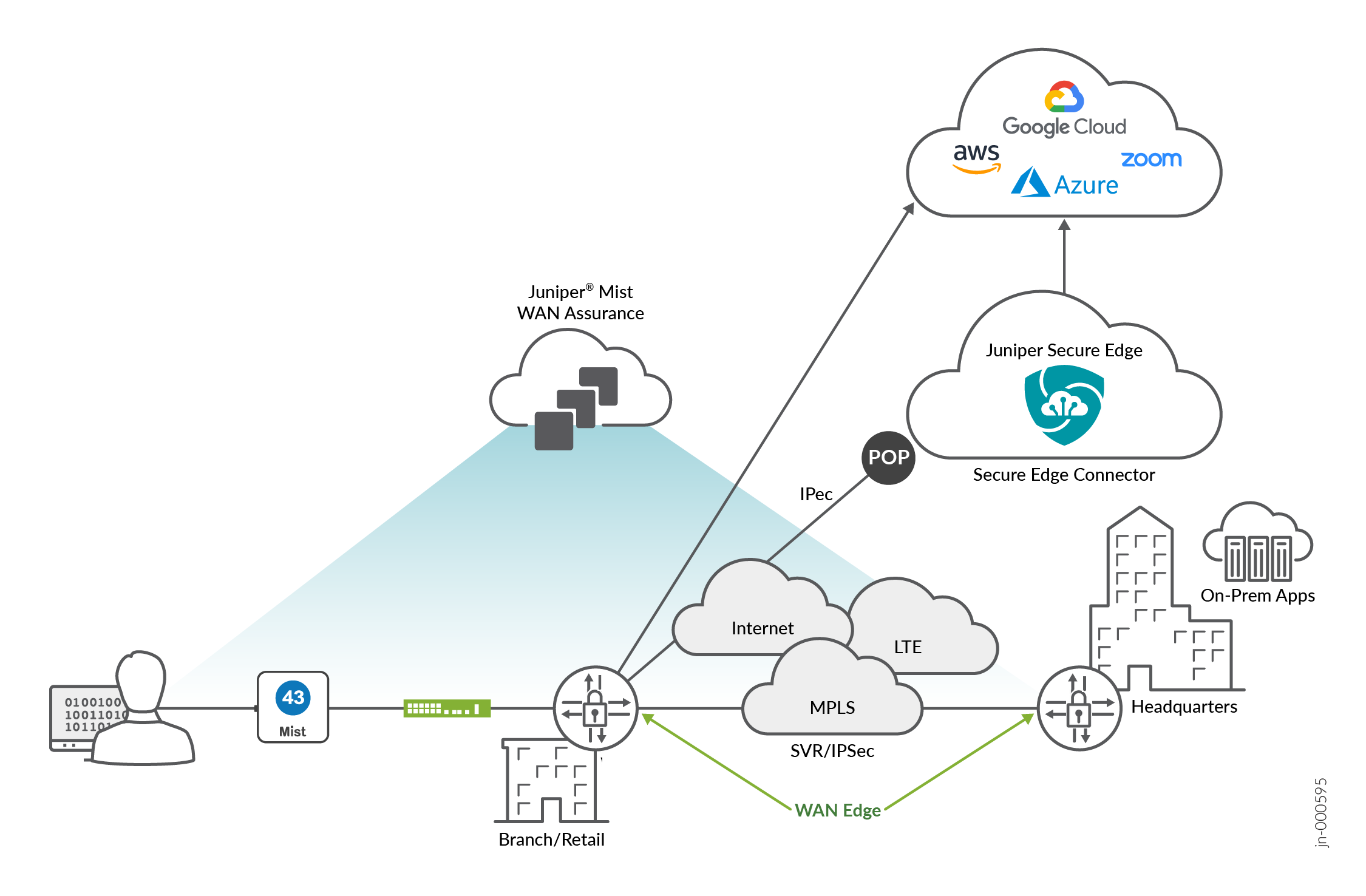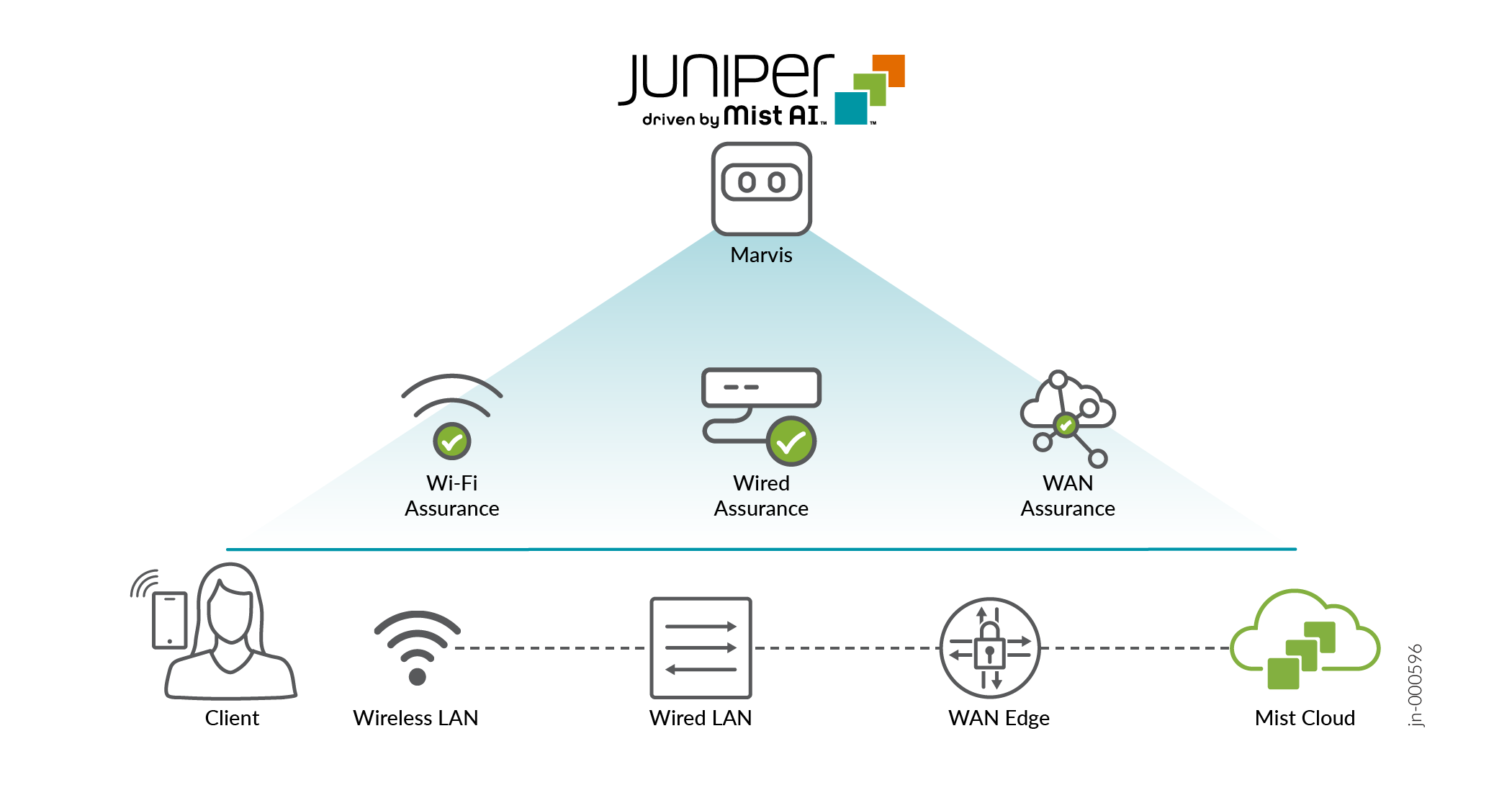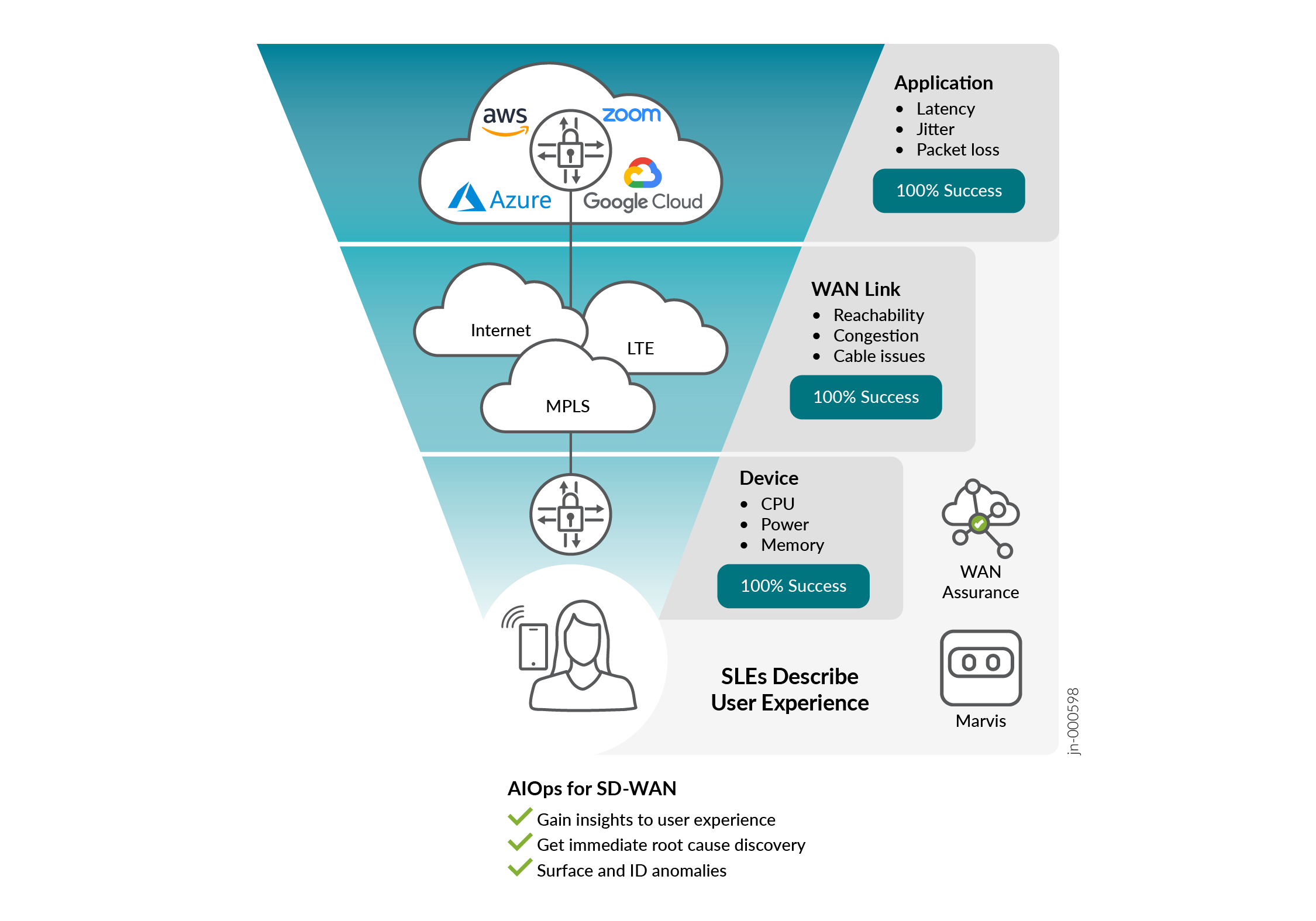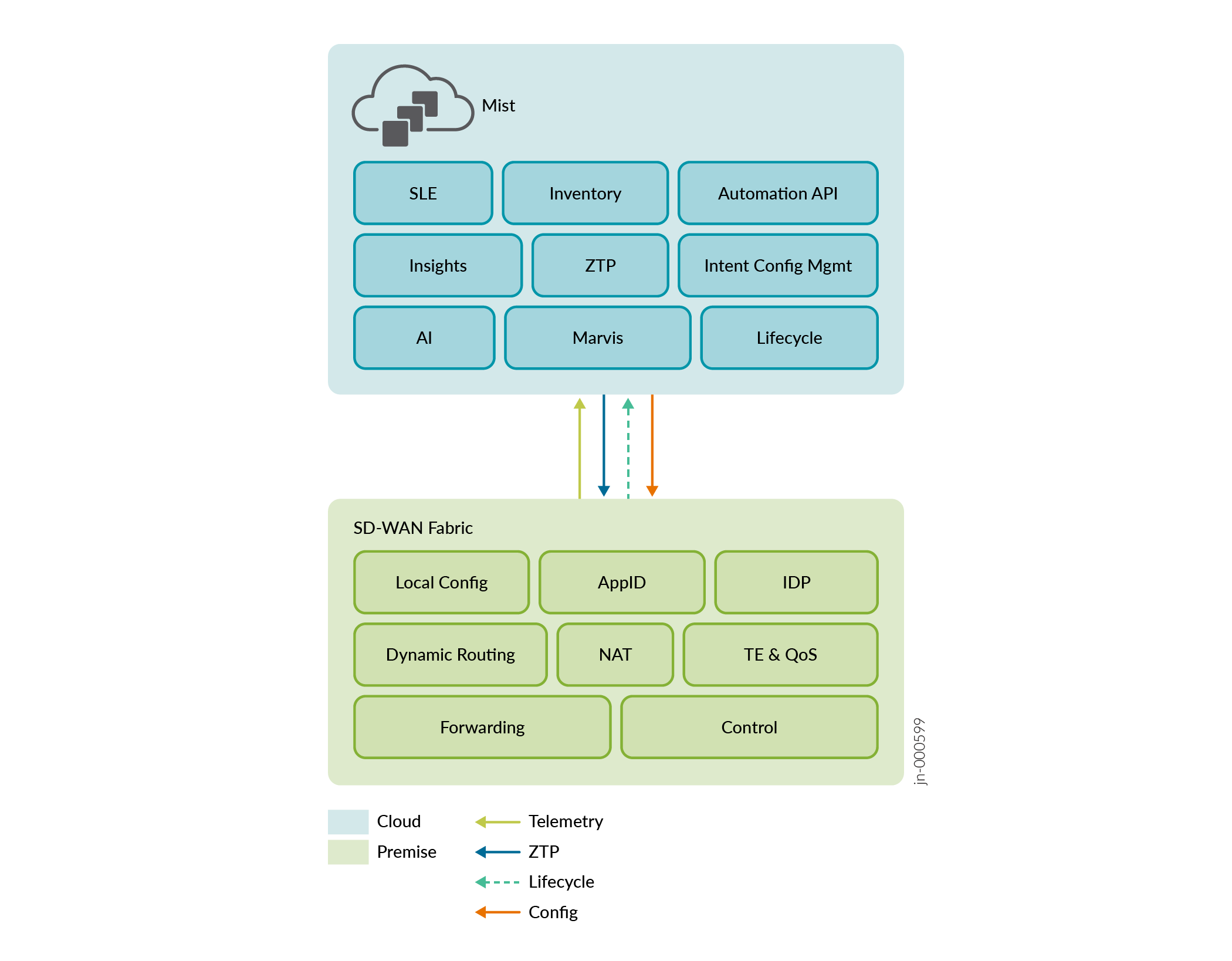Overview of Juniper Mist WAN Assurance
Get familiar with the purpose, features, and benefits of Juniper Mist™ WAN Assurance.
The WAN Edge is the demarcation point for your enterprise network to reach the outside world. This boundary is a crucial security and troubleshooting hotspot. The WAN Edge can be a simple border between your enterprise network and the outside world. However, the WAN Edge can also be a Juniper® SD-WAN driven by Mist AI™ device. Options include Juniper® SRX Series Firewalls, Juniper® Networks Session Smart™ Routers, or a cloud solution like Juniper Secure Edge.

The WAN Edge transforms with Juniper’s AI-driven SD-WAN solution and acts as your centralized policy enforcement point (PEP). Combined with the Juniper Mist WAN Assurance cloud service, the Juniper SD-WAN solves many of the legacy SD-WAN solutions' security, monitoring, and troubleshooting challenges. Bring deployment, monitoring, and troubleshooting across your network by integrating Juniper Mist Wired Assurance, Juniper Mist Wireless Assurance, and now Juniper Mist WAN Assurance. Juniper Mist WAN Assurance securely connects branch offices with Juniper® Session Smart™ Routers or Juniper® SRX Series Firewalls across the SD-WAN.

Intersite Connectivity (SD-WAN)
Your WAN Edge transforms when integrated with Juniper® SD-WAN driven by Mist AI™. Your WAN Edge device becomes fast, secure, and application-aware with Juniper Mist WAN Assurance. Software-defined WAN traffic from remote sites travels through an abstracted overlay across less expensive broadband service providers. This connectivity design replaces expensive legacy MPLS solutions. Edge devices deliver stateful failovers across various connection types, including MPLS, broadband, satellite, and LTE. This real-time switch for critical applications is imperceptible to the user. Juniper Mist WAN Assurance also brings visibility to your WAN Edge with targeted insights for health, tunnel activity, connectivity, and active sessions. By creating that software-defined space, you can influence traffic at the application level with greater control for access and security.

Juniper Mist WAN Assurance Service Level Expectations (SLEs)
Mist’s Predictive Analytics and Correlation Engine (PACE) provides data science and machine learning to understand the end-user experience. The WAN SLE metrics are: WAN Edge Health, WAN Link Health, and Application Health. Juniper Mist WAN Assurance identifies the root cause of WAN issues impacting user experiences. Service-level expectations enable simpler operations, better visibility into end-user experiences, and simplify monitoring and troubleshooting your network.

Mist Management Model
Juniper’s AI-driven SD-WAN solution is a single management platform for branch Wireless, Wired, and SD-WAN. Juniper SD-WAN zero-touch provisioning (ZTP), life cycle, and configuration are done through a single Mist dashboard.

Watch the following video for an overview of the Juniper Mist WAN Assurance feature.
Juniper MIST WAN Assurance delivers insights and troubleshooting driven by MIST AI into the WAN, exposing many factors that impact user experience across your distributed enterprise. WAN Assurance complements your SD-WAN deployment and is focused on delivering the best user experience, from client to the cloud. SD-WAN solutions dynamically optimize traffic flows across the WAN based on an SLA policy for your applications.
However, these SLAs are set once at the beginning and don't account for changes over time that impact the WAN, rendering these static SLAs ineffective. In contrast, WAN Assurance is centered around the concept of the user minute, which is represented by Service Level Expectations, or SLE for short. If a user is experiencing a poor Microsoft Teams call, then the user is having bad user minutes.
Let's see what this looks like in a Juniper Cloud instance. From the monitor view, we select WAN, choosing from the time frame over the last seven days, and we see three SLEs for the WAN. The first one is Gateway Health, which accounts for the overall state of the SRX WAN edge device itself.
We track CPU, memory, temperature, fan, and power, all of which account for the overall device health. WAN Link Health represents the overall state of the WAN connections to the device. It tracks IPsec status, routing, and the WAN interfaces.
Thirdly, there's App Experience, which accounts for factors that impact application performance based on traffic. This SLE tracks latency, jitter, packet loss, and round-trip time. Together, these three SLEs describe how WAN performance is impacting overall user experience.
Let's ask Marvis what's happening with Microsoft Teams. By simply typing, obvious Teams call is bad, Marvis begins a root cause analysis. Marvis first responds by listing five Teams sessions from the past 24 hours.
We select the troublesome session from the list. Marvis quickly responds that the bad Teams experience was due to high latency on the Gateway SRX. Marvis also shows where the issue is in a simplified network diagram.
It displays how Abhi's MacBook is connected wirelessly to an access point, which in turn is connected to an EX access switch, and finally, the traffic is sent to the WAN via the SRX gateway. Marvis visually shows how each of these points in the network are impacting user experience. We see the AP and the gateway devices may be impacting experience.
We click the AP first. There is some non-WiFi interference in the 5GIG band that could be impacting users. Next, we select the gateway device.
We see it has high latency in one of its WAN links due to slow response from the application server. Marvis makes it that easy to determine root cause analysis of issues impacting user experience. By correlating across Wi-Fi, wired, and WAN, we are able to drive a better user experience within our sites, out of our sites, from client to cloud.
